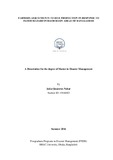Farmers adjustments to rice production in response to flood hazard in Haor basin areas of Bangladesh

View/
Date
2016Publisher
BRAC UniversityAuthor
Nahar, Jakia QuamrunMetadata
Show full item recordAbstract
The study was conducted in the Dingapota Haor of Mohangonj upazila under Netrokona district and it have been selected purposively as the study area. The boro rice growers of Dingapota Haor constituted the population of the study. An update list of 1032 boro rice growers from the selected Haor area was collected from Upazila Agricultural Offices of this locality. Around 10% of the populations were randomly selected as the sample of the study by using random sampling method. Thus, 103 boro rice growers constituted the sample of the study. A well structured interview schedule was developed based on objectives for collecting information. The researcher herself collected data through personal contact. The independent variables were: age, level of education, family size, farm size, annual income, organizational participation, communication exposure and agricultural knowledge. The dependent variable of this study was the farmers adjustments to rice production in response to flood hazard in Haor basin areas of Bangladesh. Data collection was started in 07 April, 2016 and completed in 26 April, 2016. Among the respondents, rice growers in Haor basin area in adjustment of flood hazard, the highest 55.34 percent rice growers belong to the group of lowest adjustment compared to 37.86 percent in moderate adjustment, whereas the lowest 6.80 percent rice growers belong to the group of high adjustment in response to flood hazard in Haor basin area. Pearson Product Moment Correlation Co-efficient between dependent and independent variable revealed that age, level of education, farm size, organizational participation, communication exposure and agricultural knowledge had significant positive relationships with farmers’ adjustments to rice production in response to flood hazard in Haor basin area. Annual income had non significant positive relationships, while family size had significant negative relationship with farmers’ adjustments to rice production in response to flood hazard in Haor basin area under the present study.
